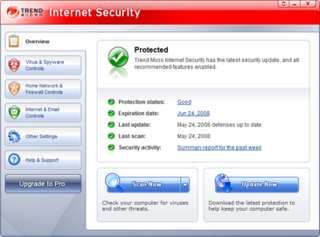Malware is any software intentionally designed to cause disruption to a computer, server, client, or computer network, leak private information, gain unauthorized access to information or systems, deprive access to information, or which unknowingly interferes with the user's computer security and privacy. Researchers tend to classify malware into one or more sub-types.

Antivirus software, also known as anti-malware, is a computer program used to prevent, detect, and remove malware.

ESET, s.r.o., is a software company specializing in cybersecurity. ESET's security products are made in Europe and provide security software in over 200 countries and territories worldwide. Its software is localized into more than 30 languages.

Microsoft Defender Antivirus is an antivirus software component of Microsoft Windows. It was first released as a downloadable free anti-spyware program for Windows XP and was shipped with Windows Vista and Windows 7. It has evolved into a full antivirus program, replacing Microsoft Security Essentials in Windows 8 or later versions.
Defensive computing is a form of practice for computer users to help reduce the risk of computing problems, by avoiding dangerous computing practices. The primary goal of this method of computing is to be able to anticipate and prepare for potentially problematic situations prior to their occurrence, despite any adverse conditions of a computer system or any mistakes made by other users. This can be achieved through adherence to a variety of general guidelines, as well as the practice of specific computing techniques.
Webroot Inc. is an American privately-held cybersecurity software company that provides Internet security for consumers and businesses. The company was founded in Boulder, Colorado, US, and is now headquartered in Broomfield, Colorado, and has US operations in San Mateo and San Diego, and globally in Australia, Austria, Ireland, Japan and the United Kingdom.
Data loss prevention (DLP) software detects potential data breaches/data exfiltration transmissions and prevents them by monitoring, detecting and blocking sensitive data while in use, in motion, and at rest.
A zero-day is a vulnerability or security hole in a computer system unknown to its owners, developers or anyone capable of mitigating it. Until the vulnerability is remedied, threat actors can exploit it in a zero-day exploit, or zero-day attack.

Symantec Endpoint Protection, developed by Broadcom Inc., is a security software suite that consists of anti-malware, intrusion prevention and firewall features for server and desktop computers. It has the largest market-share of any product for endpoint security.
Computer security software or cybersecurity software is any computer program designed to influence information security. This is often taken in the context of defending computer systems or data, yet can incorporate programs designed specifically for subverting computer systems due to their significant overlap, and the adage that the best defense is a good offense.

Comodo Internet Security (CIS) is developed and distributed by Comodo Group, a freemium Internet security suite that includes an antivirus program, personal firewall, sandbox, host-based intrusion prevention system (HIPS) and website filtering.
Trusteer is a Boston-based computer security division of IBM, responsible for a suite of security software. Founded by Mickey Boodaei and Rakesh K. Loonkar, in Israel in 2006, Trusteer was acquired in September 2013 by IBM for $1 billion.
Messaging Security is a program that provides protection for companies' messaging infrastructure. The programs includes IP reputation-based anti-spam, pattern-based anti-spam, administrator defined block/allow lists, mail antivirus, zero-hour malware detection and email intrusion prevention.
Mobile security, or mobile device security, is the protection of smartphones, tablets, and laptops from threats associated with wireless computing. It has become increasingly important in mobile computing. The security of personal and business information now stored on smartphones is of particular concern.

Trend Micro Internet Security is an antivirus and online security program developed by Trend Micro for the consumer market. According to NSS Lab comparative analysis of software products for this market in 2014, Trend Micro Internet Security was fastest in responding to new internet threats.
Lastline, Inc. is an American cyber security company and breach detection platform provider based in Redwood City, California. The company offers network-based security breach detection and other security services that combat malware used by advanced persistent threat (APT) groups for businesses, government organizations and other security service providers. Lastline has offices in North America, Europe, and Asia.
Cyber threat hunting is a proactive cyber defence activity. It is "the process of proactively and iteratively searching through networks to detect and isolate advanced threats that evade existing security solutions." This is in contrast to traditional threat management measures, such as firewalls, intrusion detection systems (IDS), malware sandbox and SIEM systems, which typically involve an investigation of evidence-based data after there has been a warning of a potential threat.
Deception technology is a category of cyber security defense mechanisms that provide early warning of potential cyber security attacks and alert organizations of unauthorized activity. Deception technology products can detect, analyze, and defend against zero-day and advanced attacks, often in real time. They are automated, accurate, and provide insight into malicious activity within internal networks which may be unseen by other types of cyber defense. Deception technology seeks to deceive an attacker, detect them, and then defeat them.
This is a list of cybersecurity information technology. Cybersecurity is security as it is applied to information technology. This includes all technology that stores, manipulates, or moves data, such as computers, data networks, and all devices connected to or included in networks, such as routers and switches. All information technology devices and facilities need to be secured against intrusion, unauthorized use, and vandalism. Additionally, the users of information technology should be protected from theft of assets, extortion, identity theft, loss of privacy and confidentiality of personal information, malicious mischief, damage to equipment, business process compromise, and the general activity of cybercriminals. The public should be protected against acts of cyberterrorism, such as the compromise or loss of the electric power grid.
Extended detection and response (XDR) is a cybersecurity technology that monitors and mitigates cyber security threats.





